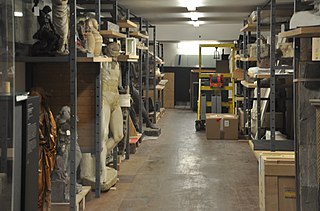
The Smithsonian Institution, or simply the Smithsonian, is a group of museums and education and research centers, the largest such complex in the world, created by the U.S. Government "for the increase and diffusion of knowledge". Founded on August 10, 1846, it operates as a trust instrumentality and is not formally a part of any of the three branches of the federal government. The institution is named after its founding donor, British scientist James Smithson. It was originally organized as the United States National Museum, but that name ceased to exist administratively in 1967.

The Field Museum of Natural History (FMNH), also known as The Field Museum, is a natural history museum in Chicago, Illinois, and is one of the largest such museums in the world. The museum is a popular natural-history museum for the size and quality of its educational and scientific programs, as well as due to its extensive scientific-specimen and artifact collections. The permanent exhibitions, which attract up to two million visitors annually, include fossils, current cultures from around the world, and interactive programming demonstrating today's urgent conservation needs. The museum is named in honor of its first major benefactor, the department-store magnate Marshall Field. The museum and its collections originated from the 1893 World's Columbian Exposition and the artifacts displayed at the fair.

The Arthur M. Sackler Gallery is an art museum of the Smithsonian Institution in Washington, D.C., focusing on Asian art. The Sackler Gallery and the Freer Gallery of Art together form the National Museum of Asian Art in the United States. The Freer and Sackler galleries house the largest Asian art research library in the country.

The Canadian Museum of Nature is a national natural history museum based in Canada's National Capital Region. The museum's exhibitions and public programs are housed in the Victoria Memorial Museum Building, a 18,910 square metres (203,500 sq ft) structure in Ottawa, Ontario. The museum's administrative offices and scientific centres are housed at a separate location, the Natural Heritage Campus, in Gatineau, Quebec.

The National Museum of Natural History is a natural history museum administered by the Smithsonian Institution, located on the National Mall in Washington, D.C., United States. It has free admission and is open 364 days a year. In 2016, with 7.1 million visitors, it was the eleventh most visited museum in the world and the most visited natural history museum in the world after the ones of Chongqing, London and Shanghai. Opened in 1910, the museum on the National Mall was one of the first Smithsonian buildings constructed exclusively to hold the national collections and research facilities. The main building has an overall area of 1.5 million square feet (140,000 m2) with 325,000 square feet (30,200 m2) of exhibition and public space and houses over 1,000 employees.

Cooper Hewitt, Smithsonian Design Museum is a design museum located in the Upper East Side's Museum Mile in Manhattan, New York City. It is one of 19 museums that fall under the wing of the Smithsonian Institution and is one of three Smithsonian facilities located in New York City, the other two being National Museum of the American Indian's George Gustav Heye Center in Bowling Green and the Archives of American Art New York Research Center in the Flatiron District. It is the only museum in the United States devoted to historical and contemporary design. Its collections and exhibitions explore approximately 240 years of design aesthetic and creativity.

The Smithsonian American Art Museum is a museum in Washington, D.C., part of the Smithsonian Institution. Together with its branch museum, the Renwick Gallery, SAAM holds one of the world's largest and most inclusive collections of art, from the colonial period to the present, made in the United States. The museum has more than 7,000 artists represented in the collection. Most exhibitions take place in the museum's main building, the old Patent Office Building, while craft-focused exhibitions are shown in the Renwick Gallery.

The University of California, Santa Cruz (UCSC) Coastal Science Campus consists of five main institutions: UCSC's Long Marine Laboratory, UCSC's Coastal Biology Building, the Southwest Fisheries Science Center, the Seymour Marine Discovery Center, and the Marine Wildlife Veterinary Care and Research Center. The physical location of the campus is at the western end of Santa Cruz, California, roughly 10 minutes away from UCSC's main campus, and is located adjacent to the Younger Lagoon Reserve. Walking trails exist throughout the campus and are used by area residents for walking, biking, and bird watching.

The National Anthropological Archives is a collection of historical and contemporary documents maintained by the Smithsonian Institution, which document the history of anthropology and the world's peoples and cultures. It is located in the Smithsonian's Museum Support Center in Suitland, Maryland, and is part of the Department of Anthropology at the National Museum of Natural History.

Smithsonian Libraries and Archives is an institutional archives and library system comprising 21 branch libraries serving the various Smithsonian Institution museums and research centers. The Libraries and Archives serve Smithsonian Institution staff as well as the scholarly community and general public with information and reference support. Its collections number nearly 3 million volumes including 50,000 rare books and manuscripts.
The Smithsonian's Museum Conservation Institute (MCI) aims to be the center for specialized conservation and technical collection research for all of the Smithsonian museums and collections. MCI's staff combine state-of-the-art instrumentation and scientific techniques with the knowledge of materials and the history of technology to provide technical research studies and interpretation of art, as well as historical and anthropological objects, to improve the conservation and collections storage capabilities at the Smithsonian. For the majority of the Smithsonian collections, MCI is the only Smithsonian resource for technical studies and analyses.

The Department of Entomology is a research department and collection unit of the Smithsonian Institution's National Museum of Natural History (NMNH), located in Washington, DC. The department houses the U.S. National Insect Collection, one of the largest entomological collections in the world, with over 35 million specimens housed in 132,354 drawers, 33,000 jars or vials, and 23,000 slides in more than 5,200 cabinets. The department also includes research scientists and technical staff from the Smithsonian Institution, the United States Department of Agriculture Systematic Entomology Lab (SEL) and United States Department of Defense Walter Reed Biosystematics Unit (WRBU).

A collection manager ensures the proper care and preservation of objects within cultural institutions such as museums, libraries, and archives. Collection managers, along with registrars, curators, and conservators, play an important role in collections care. Collection Managers and Registrars are two distinct collection roles that are often combined into one within small to mid-size cultural institutions. Collection Managers can be found in large museums and those with a history and natural history focus whose diverse collections require experienced assessment to properly sort, catalog, and store artifacts. A collection manager may oversee the registrar, archivist, curator, photographer, or other collection professionals, and may assume the responsibilities of these roles in their absence within an organization.

Collections management involves the development, storage, and preservation of cultural property, as well as objects of contemporary culture in museums, libraries, archives and private collections. The primary goal of collections management is to meet the needs of the individual collector or collecting institution's mission statement, while also ensuring the long-term safety and sustainability of the cultural objects within the collector's care. Collections management, which consists primarily of the administrative responsibilities associated with collection development, is closely related to collections care, which is the physical preservation of cultural heritage. The professionals most influenced by collections management include collection managers, registrars, and archivists.

The Indian Institute of Spices Research (IISR) is an autonomous organization engaged in agricultural research related to spices in India. The institute has its headquarters in Moozhikkal, Silver Hills, Kozhikode, Kerala and is a subsidiary of Indian Council of Agricultural Research (ICAR), New Delhi, under the Ministry of Agriculture, India.
The conservation and restoration of time-based media art is the study and practice of conserving time-based media and its components to ensure the longevity of the works. The conservation and restoration of time-based media art is a complex undertaking within the field of conservation that includes understanding both physical and digital conservation methods of the many facets of time-based media conservation. The overall intention is based on how to monitor and detect from the possible changes made to in artwork overtime. These changes could include short, medium, and long-term effects as a result or response to the environment, exhibition-design, technicians, preferences, or technological development. The conservation and restoration of time-based media art be determined through its conservation and preservation strategies, continual education and training, and resources available from institutions and organization across the globe.

A textile conservator is a conservator-restorer charged with the care, treatment, research, and preservation of textiles. Issues addressed by a textile conservator are generally related to the field of textile preservation, and include damage caused to textiles by: light, mold and mildew, insects, cleaning, surface cleaning, washing, mounting for display, and storage. Variations in textile types and “the diversity of the textile conservator’s work makes it a very rewarding profession”. Textiles are among the most fragile artifacts, as they are susceptible to damage from atmospheric pollutants, moisture, biological organisms, and environmental changes and care varies with size, shape, material, and condition issues, all of which a textile conservator must be well versed.

The conservation and restoration of human remains involves the long-term preservation and care of human remains in various forms which exist within museum collections. This category can include bones and soft tissues as well as ashes, hair, and teeth. Given the organic nature of the human body, special steps must be taken to halt the deterioration process and maintain the integrity of the remains in their current state. These types of museum artifacts have great merit as tools for education and scientific research, yet also have unique challenges from a cultural and ethical standpoint. Conservation of human remains within museum collections is most often undertaken by a conservator-restorer or archaeologist. Other specialists related to this area of conservation include osteologists and taxidermists.
Conservation and restoration at the Smithsonian Institution deals with the care of the 138 million artifacts located in the collections of Smithsonian Institution. Work is conducted by one research center, the Museum Conservation Institute (MCI), and by conservators at the Smithsonian's museums, galleries, zoo. Smithsonian conservators provide myriad services to their units, including exhibit preparation of the museum collection and loan objects, advising on object care, training for future generations of conservationists, engaging in routine preventive care on a daily basis, conducting research projects related to the collections, and examining objects for evidence of manufacturing techniques and previous restorations All conservation labs collectively further the mission of the Smithsonian Institution, "the increase and diffusion of knowledge." Founded in 1846 the Smithsonian is the world's largest museum and research complex, consisting of 19 museums and galleries, the National Zoological Park, and nine research facilities.
Carolyn L. Rose was an archaeological conservator for the Smithsonian Institution and one of the first ethnographic conservators in the United States.















